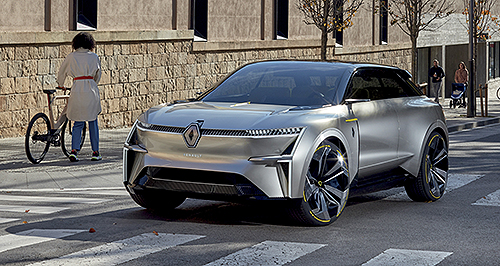Future models - Renault - MorphozRenault reveals electric Morphoz concept carRenault shows off its vision for the future with new Morphoz electric concept car4 Mar 2020 RENAULT has ripped the covers off its latest electric concept car, the Morphoz, an electric vehicle (EV) with level three autonomous driving functions that precedes the arrival of Renault’s new electric line-up due from next year.
Built on the Renault-Nissan-Mitsubishi Alliance's future CMF-EV modular electric platform, two versions of the Morphoz have been outlined by Renault – the City version and the Travel version – each with their own unique powertrains and configurations.
The City version measures in at 4400mm long, 2000mm wide and sits on a 2700mm wheelbase to both maximise cabin space and ensure there is enough room to house its 40kWh batteries, units Renault describes as “just the right battery capacity to meet day-to-day requirements”.
Claimed range is 400km while the power figure stands at an even 100kW – no torque figure is given – all of which is put to the road by the front wheels.
Stepping up to the Travel version adds an extra 200mm to the wheelbase and an extra 400mm to the overall length with some of the space taken up by additional 50kWh batteries which help to extend the claimed range from 400km to 700km and boost power from 100kW to 160kW – drive still goes through the front wheels.
Naturally being a longer version of the same platform the Travel scores extra legroom as well as cargo space although exact capacities have not been revealed.
There are also some subtle styling differences between the two with the City version brandishing a signature light arrangement bolstered by extra LEDs compared to the more aerodynamic Travel.
Both cars roll on striking 22-inch chrome five-spoke alloy wheels and share similar front and rear fascias – even with the differing headlight arrangements – with the front sharing a few similarities with the current Toyota C-HR, those being the prominent but thin front grill, narrow frowning style headlights, trapezium-shaped lower intake and angular channels at either end of the bumper.
At the rear there is an Alfa Romeo Brera-esque tailgate with thin LED light strips taking care of tail-light duties while the City version also scores a few extra vents and air channels than its bigger counterpart.
Ingress and egress are taken care of by four pillarless doors with the rears utilising a suicide-style action with all four opening to reveal the lack of a fixed B-pillar.
The side profile reveals a high window line and fairly standard crossover roofline though the rear window is heavily raked forward meaning the curved tailgate protrudes further than the roof-mounted spoiler or rear bumper.
Inside there are four individual seats finished in yellow cloth with a “share” mode fitted to the passenger seat allowing it to swivel 180 degrees to face backwards, allowing the passenger to fully interact with the rear passenger(s).
Being a level three autonomous vehicle, Renault says drivers can “delegate the driving to the vehicle in certain defined situations on authorised roads” like freeways or in traffic jams.
This includes maintaining safe distances from other cars, lane keeping and speed control although the driver must be prepared to retake control within seconds of being notified by the system.
Connectivity and artificial intelligence are also central to the Morphoz according to Renault, with the car able to recognise its owner as they approach and unlock when it ‘sees’ the person wave at it.
“The driver just waves to activate the welcome sequence, which unlocks and opens the doors, automatically positions the seat and adjusts the interior lighting to the driver’s preferences and mood,” the brand said.
Once the driver is inside and comfortable, the AI system sets about becoming a personal assistant in optimising schedules, automatically recognising and connecting smartphones (with permission), route planning and even suggesting points of interest in the Travel version.
Exterior and rearview mirrors have been replaced by a series of cameras while light displays on the inner doors and windows signal objects in the vehicle’s blind spots.
Last year Renault sold 8364 vehicles in Australia, 1384 less than in 2018 (-13.8 per cent).
In January this year it managed 420 sales, 174 units down on 2019 or a drop of 29.3 per cent.  Read more |
Click to shareRenault modelsResearch Renault Motor industry news |

















Facebook Twitter Instagram